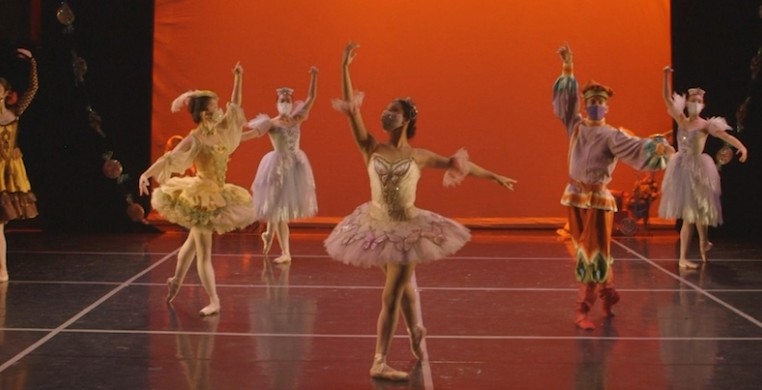This year, the Ruth Page Center for the Arts and affiliated Civic Ballet of Chicago presents an inside look at an historic Chicago institution with “Visions: A Nutcracker Experience.” Selections from dance icon Ruth Page’s “Nutcracker” are performed by two casts, presented à la carte and streamable at home. With social distancing in mind, solo and lead performances are broken up by brief character cameos—blink and you’ll miss an adorable Arabian (Essamuel Kuntz), a famished Mouse King (Xavier Lillig) and two cheeky Bon Bons (Isabella Moore and Klein Khim).
Page’s long-running version of the ballet is complemented by additional choreography from Dolores Long and Birute Barodicaite. It is set against expertly-painted backdrops, with lithe bodies clothed in internationally-flavored costumes by José Verona and given a celestially pastoral splash of turquoise and magenta by lightning designer Sarah Lackner.
Available now through Dec. 20, “Visions” is not your typical “Nutcracker.” At just 28 minutes, it evokes an element of guerilla theater as the camera winds around the narrow halls and steep staircases of the Center, home to the Ruth Page School of Dance. The production was originally planned as a guided tour for audience members, 10 at a time. But a new stay-at-home advisory, put into place less than a week before the scheduled premiere on Dec. 4, put the kibosh on live productions. The Center pivoted to plan B, filming and packaging it for digital audiences to view online.
All of the performances in “Visions'' take place in the Center’s many decorated dance studios and main stage. Quaint and charming dressed-up studios, within the boxed-in frame of the camera, made me feel like I was one of Drosselmeyer’s wooden soldiers, a tiny spectator watching from inside a weathered-old toy chest.
The production would fare better by having all numbers perform on the main stage, which allows the dancers to move with impunity, unencombered by tight spaces and exposed ballet barres. In the studios, the dancers are hampered by the close quarters. The dancers are sometimes a little behind the music—though this may be the fault of the sound being slightly “off” from the video. Three of the pas de trois treatments of the ballet’s popular divertissements has dancers moving at a snail’s pace, while performing développé variations across the floor in “Dance of the Reed Pipes,“ for example. And a too-close camera loses much of the grandeur of billowing flamenco dresses during spinning fan kicks in the “Spanish Dance.” I can understand the need for artists to make sacrifices and use time and space efficiently right now, but such grandiose numbers look cramped and smooshed when performed in a box.
The main stage numbers have the oomph that the studio lacks. Rigoberto Saura—known to Chicagoans for his work with such companies as Hedwig Dances and Thodos Dance Chicago—adds an appreciated virtuosity, culminating the “Russian Dance” with a string of high Cossack-inspired kicks framed well against a backdrop of onion-domed cathedrals. Sugar Plum soloist Karen Niño has ample room to complete full phrases of accented, traveling battements from one end to the other, speckled with violet lights reflecting off shiny, oversized candy decorations hanging overhead. The finale features the largest number of bodies on the main stage yet—seven—and serves as an appropriate representative for a full-company closer.
A good compromise of space can be found in the “Waltz of the Snowflakes” which takes place in what appears to be the Center’s largest studio. Usually set on a large company of dancers, this version of “Snowflakes” is trimmed down to six sparkling winter faeries who zip about as gracefully as their namesake implies. The extra room and fuller ensemble make it much easier to appreciate the oscillating rhythmic counterpoint in their frothy footwork.
Between each vignette we are led by a jubilant host through short scenes of theatrical exposition, some of which are acted by the staff of the Center itself: Director Victor Alexander is a hard-at-work Drosselmeyer putting the finishing touches on a new toy that comes to life in his office-turned-workshop. Other cameos from Center staff Kayla McGrath, Anne Lau-Minden, La Mar Brown and Austin Shirley can be caught by those canny enough to recognize them. As we explore the Center’s labyrinthine interiors, visible stage lighting, abrupt musical fadeouts and inconsistent video quality give the production a home-movie vibe.
This is a sure contrast to the generally uber-produced winter ballets to which we’ve grown accustomed. And is a far cry from the caliber of performance one usually expects from the Ruth Page Civic Ballet. I have no doubt that, in years to come, repeat viewings will elicit much elbow nudging, eye-rolling and genuine sentiments of camaraderie. Not to be a Scrooge, but at the price point I expected something more along the lines of Page’s traditional "Nutcracker." “Visions” feels more like a well-intentioned slideshow of a family vacation. Recently, there have been other Chicago dance companies that have put on full performances with new work at a “pay what you can” rate to help ease pandemic tensions, so I am left a little confused if “Visions” is made for a general audience or just friends and family of the Center.
Though I am underwhelmed by the presentation, the Ruth Page Center for the Arts deserves a little credit for getting creative and attempting to produce new art during a global crisis after suffering setbacks to their original plans—no easy feat! The in-house cast, familiar interior and a chance to see samplings of Page & Co.’s distinctive works makes “Visions'' a virtual time capsule that will delight students who have passed through the iconic studio and may tide over die-hard fans of the Center’s predominant matriarch until next year.
--
“Visions: A Nutcracker Experience” runs through Dec. 20 online. Tickets are $25-$45 for 30-day access, available at RuthPage.org or by clicking the event link below.


